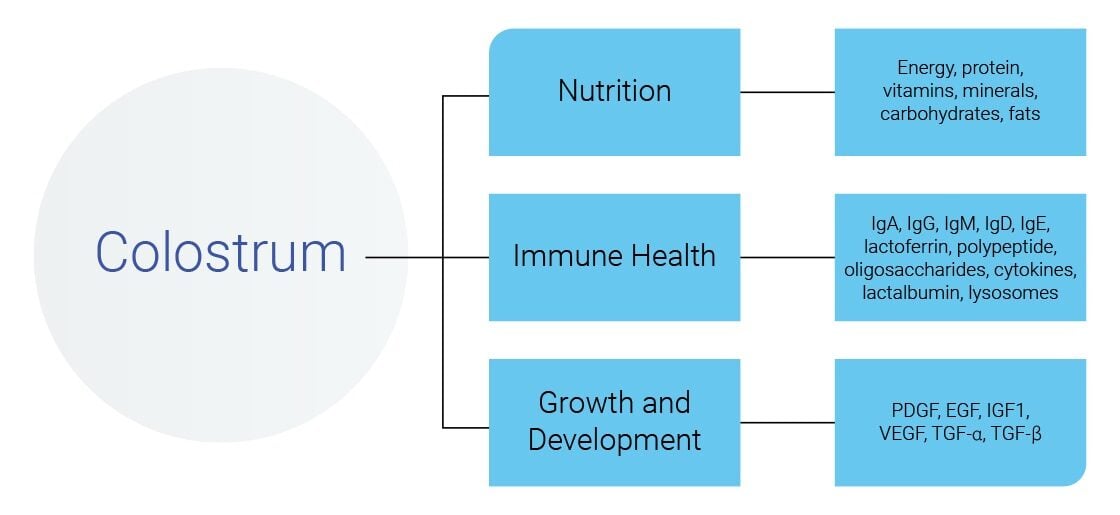Are you sure you want to leave 's MyShop site?
Are you sure you want to leave 's MyShop site?
Are you sure you want to leave 's MyShop site?
Are you sure you want to leave 's MyShop site?

Colostrum is a highly nutritious form of breast milk mammals produce that promotes their newborn’s health in the first few days of life. Over the years, research has uncovered the mechanisms responsible for colostrum’s health benefits and illuminated its potential to support health across lifespan. Read on for an in-depth review of colostrum.
Colostrum is the thick, yellowish fluid produced by mammals, including humans, during the first few days after giving birth. It is often referred to as "first milk." Colostrum is packed with essential nutrients, immune-boosting antibodies, and growth factors, making it extremely beneficial for the newborn's health and development. As the newborn grows, colostrum transitions into mature breast milk, which goes through different phases to meet the evolving nutritional needs of the baby.
1: Colostrum
Colostrum is packed with essential nutrients and other bioactive compounds that are vital to a newborn’s health and development. Compared to mature milk (or phase 3 milk), colostrum has more fats, proteins, vitamins, minerals, hormones, growth factors, and other bioactive compounds, such as antibodies and immune system components.1 After three days, the concentration of these compounds decreases rapidly.
2: Transitional Milk
Transitional milk is produced as colostrum changes to mature milk. The transition to mature milk takes about two weeks and begins two to five days after giving birth. Transitional milk has high levels of fat, lactose, and water-soluble vitamins and contains more calories than colostrum.2
3: Mature Milk
Mammals produce mature milk roughly two weeks after giving birth. Mature milk is the form of milk made for the duration of breastfeeding. The composition of mature milk is drastically different than colostrum. Ten percent of mature milk is made up of essential nutrients (carbs, proteins, fats, vitamins, and minerals), whereas the other ninety percent is water.2
There are two types of mature milk: foremilk and hindmilk. Foremilk is present at the beginning of feedings and contains greater amounts of water, vitamins, and proteins. Hindmilk is produced later in the feeding and contains higher levels of fat.

As noted above, colostrum contains a unique profile of essential nutrients and other bioactive compounds. Colostrum contains more macro and micronutrients than both mature breast milk and cow’s milk. Compared to cow’s milk, colostrum has greater amounts of proteins; fats; carbs; magnesium; B vitamins; and vitamins A, C, and E.3 These nutrients play an important role in growth and development; however, the bioactive compounds are responsible for the majority of colostrum’s health benefits.
Immune Health Support
There are multiple components of colostrum that work in various ways to support immune system function.4 Examples include:
Growth Factors
Growth factors are proteins that promote the growth and development of cells and tissues in your body.5 There are a number of growth factors present in colostrum (see image above for examples).
The nutrients and compounds found in colostrum function in various ways to promote human health. In newborns, these components help stimulate growth, activate the immune system, and jumpstart gut function.6
In recent years, colostrum supplements have gained popularity among adults. Supplements are typically made using cow colostrum. Cow (or bovine) colostrum is similar in composition to human colostrum and has substantial potential to promote human health well beyond the infant years.7 Findings from clinical studies suggest that bovine colostrum:
Colostrum is the first milk mammals produce in the first few days after giving birth. This nutrient-packed form of milk helps jumpstart a newborn’s growth and development; however, clinical studies have examined colostrum’s potential to promote human health across lifespan. Though more research is needed to determine the efficacy of colostrum supplements, it appears that consuming colostrum beyond the infant years offers numerous health benefits.
Check out 4Life Fundamentals Fortified Colostrum and other 4Life Transfer Factor products which feature the immune–supporting power of colostrum and additional key ingredients to reinforce and support the immune system, digestive system, and respiratory system.*
References**
1. https://wicbreastfeeding.fns.usda.gov/phases-breast-milk
2. https://americanpregnancy.org/healthy-pregnancy/breastfeeding/breastfeeding-overview-copy/#:~:text=Transitional%20milk%20occurs%20after%20colostrum,contains%20more%20calories%20than%20colostrum.
3. https://www.healthline.com/nutrition/bovine-colostrum#nutrition
4. https://www.frontiersin.org/articles/10.3389/fimmu.2017.00584/full
5. http://www.foodandnutritionjournal.org/volume1number1/colostrum-its-composition-benefits-as-a-nutraceutical-a-review/
6. https://americanpregnancy.org/healthy-pregnancy/breastfeeding/colostrum-is-superfood-for-your-newborn/
7. Arslan A, Kaplan M, Duman H, Bayraktar A, Ertürk M, Henrick BM, Frese SA and Karav S (2021) Bovine Colostrum and Its Potential for Human Health and Nutrition. Front. Nutr. 8:651721. doi: 10.3389/fnut.2021.651721
You are trying to view a MyShop page. Please log out in order to view this website.